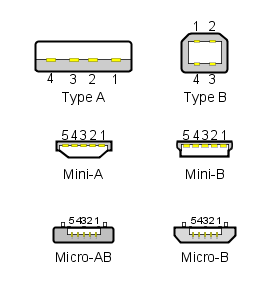USB Facts:
USB stands for Universial Serial Bus.
Micro USB plugs are going to superceed the Mini plugs by 2009. The Mini plugs are about the same width, but they are half the thickness - making them ideal for mobile phones and other slim devices. Unfortunately the cables for the Mini and Micro are not interchangable!
USB 1.1 maximum cable length is 3m.
USB 2.0 maximum cable length is 5m. Maximum permitted hubs connected in series is 5.Hence a 30m cable can be assembled using 5 hubs. A USB 2.0 hub can supply 500mA. Any device plugged into the hub will draw at least 100mA.
Maximum permitted number of devices connected to a single host interface is 127 (due to 7-bit device addresses).
USB power is 5V.
Firewire
Firewire has a 30V+ on pin 1 of the 6 pin plug, pin 2 is ground. The 4 pin plug does not have power.
Maximum cable length to the standard is 4.5m.
SATA
SATA stands for Serial Advanced Technology Attachment. Most Hard drives today are connected by SATA connections.
eSATA is the external connector that plugs into the internal SATA port on the motherboard. Maximum cable length for an eSATA cable is 2m. eSATA ports do not supply power.
An advantange of using eSATA connector for external drives is that the external drive is essentially plugged directly into the motherboard at full efficiency; ie: an interface is not required to convert it to USB or Firewire standards.
Comparison
|

USB Plug Types
|

Firewire Plug
|